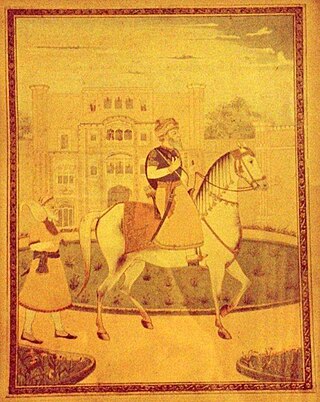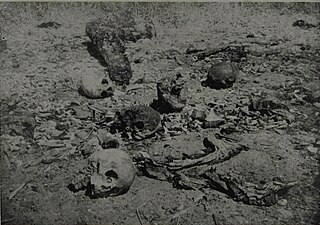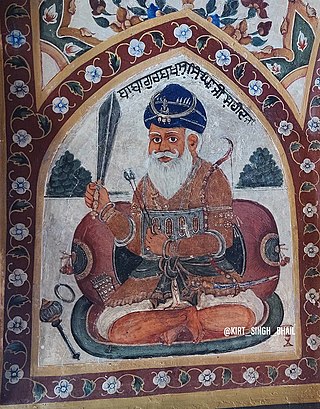
Hari Singh Nalwa was Commander-in-chief of the Sikh Khalsa Fauj, the army of the Sikh Empire. He is known for his role in the conquests of Kasur, Sialkot, Attock, Multan, Kashmir, Peshawar and Jamrud. Hari Singh Nalwa was responsible for expanding the frontier of Sikh Empire to beyond the Indus River right up to the mouth of the Khyber Pass. At the time of his death, the western boundary of the empire was Jamrud.

Jassa Singh Ramgarhia (1723–1803) was a prominent Sikh leader during the period of the Sikh Confederacy. He was the founder of the Ramgarhia Misl.

Sultan-ul-Qaum Sardar Jassa Singh Ahluwalia was a Sikh leader during the period of the Sikh Confederacy, being the Supreme Leader of the Dal Khalsa. He was also Misldar of the Ahluwalia Misl. This period was an interlude, lasting roughly from the time of the death of Banda Bahadur in 1716 to the founding of the Sikh Empire in 1801. He founded the Kapurthala State in 1772.
Sardar Hari Singh Dhillon was an 18th century Jat Sikh warrior and the chief of Bhangi Misl. During the formation of the Dal Khalsa he was acknowledged as leader of Taruna Dal, he was made chief of Bhangi Misl, the most powerful of all Misls.

Vadda Ghalughara was the mass murder of unarmed Sikhs by the Afghan forces of the Durrani Empire during the years of Afghan influence in the Punjab region of the Indian subcontinent owing to the repeated incursions of Ahmad Shah Durrani in February 1762. It is distinguished from the Chhota Ghalughara. Mostly non-combatants were killed in the event, and an estimated that 10,000 to 50,000 Sikhs were killed on 5 February 1762.

The Dallewalia misl was a Khatri Sikh state in 18th century India. The founder of this Misl was Sardar Gulab Singh resident of the village of Dallewal near Dera Baba Nanak, in Doaba Bist Jalandhar. He took Pahul and became an active member of the Dal Khalsa in 1726 A.D and launched upon a career of chivalry, fighting against the tyrannical government of the Punjab. One day at the head of 150 comrades, he attacked Jalandhar and having obtained a rich booty all of them returned to their camp in the jungle safely.

Sardar Charat Singh, also romanised as Charhat Singh, was the founder of Sukerchakia Misl and father of Mahan Singh, and the grandfather of Ranjit Singh. He distinguished himself at an early age in campaigns against Ahmad Shah Abdali and along with 150 horsemen split from the Singhpuria Misl to establish the Sukerchakia Misl.

Akali Phula Singh Nihang was an Akali Nihang Sikh leader. He was a saint soldier of the Khalsa Shaheedan Misl and head of the Budha Dal in the early 19th century. He was also a senior general in the Sikh Khalsa Army and commander of the irregular Nihang of the army. He played a role in uniting Sikh misls in Amritsar. He was not afraid of the British who at many times ordered for his arrest but were not successful. During his later years he served for the Sikh Empire as a direct adviser to Maharaja Ranjit Singh. He remained an army general in many famous Sikh battles up until his martyrdom in the battle of Nowshera. He was admired by the local people and had a great influence over the land and his settlement was always open to help the poor and helpless. He was well known and was a humble unique leader and prestigious warrior with high character. He was also known for his effort to maintain the values of Gurmat and the Khalsa panth.

The Afghan–Sikh wars spanned from 1748 to 1837 in the Indian subcontinent, and saw multiple phases of fighting between the Durrani Empire and the Sikh Empire, mainly in and around Punjab region. The conflict's origins stemmed from the days of the Dal Khalsa, and continued after the Emirate of Kabul succeeded the Durrani Empire.
The Battle of Sialkot took place on 12 November 1763, between the Durrani Empire, led by Jahan Khan, and the Sukerchakia Misl, led by Charat Singh, as part of the Afghan-Sikh wars which concluded with Sikh victory.

Ahmad Shah Durrani, the founder of the Durrani Empire, invaded Indian subcontinent for eight times between 1748 and 1767, following the collapse of Mughal Empire in the mid-18th century. His objectives were met through the raids and deepened the political crisis in India.

The Battle of Amritsar, also known as the Battle of Gohalwar, was fought between the Durrani Empire and Shaheedan Misl of the Dal Khalsa on 11 November 1757. Following the fourth invasion of Ahmad Shah Durrani, his army was attacked by Sikh bands under the command of Ala Singh and Baba Deep Singh. Following the attacks, Ahmad Shah desecrated the Sikh holy site known as the Shri Harmandir Sahib in Amritsar. The news of the desecration reached Baba Deep Singh who vowed to liberate the holy site from the Afghans. This resulted in a pitched battle being fought in the village of Gohalwar, near Amritsar. The battle resulted in Baba Deep Singh being killed and an Afghan victory.

Tara Singh Ghaiba was an associate member of the Dallewalia Misl, who became the Leader of the Misl after the death of their founding member and head Sardar Gulab Singh Khatri. He made Rahon the capital of his Misl.
Sardar Gulab Singh was the founder of Dallewalia Misl, one of the sovereign states of the Sikh confederacy that rose during the 18th century in the Punjab region. The Dallewalia and Nishanwalia Misl were stationed as a reserve force at Amritsar to protect the holy city and tackle any emergency. The Amritsar and the Punjab region was subject to raids by the Afghans led by Ahmad Shah Abdali therefore the Sikhs had created misls to defend the Punjab region and push back the invaders.
The Battle of Mahilpur was fought between the Sikh Misls and Adina Beg Khan against the Durrani Empire in December 1757.Following the 4th invasion of Ahmad Shah Durrani, he would appoint Timur Shah as the viceroy of Punjab with Jahan Khan as his deputy.The Afghans would appoint Adina Beg Khan as the faujdar of the Jalandhar Doaba and exempted him from attending court at lahore, on the condition that Adina Beg pay revenue to the Afghan government.Soon a dispute regarding the payment of revenue occurred between Adina Beg and the Afghans.This dispute soon escalated which resulted in Jahan Khan sending an Afghan force to arrest Adina Beg.Adina Beg formed a military alliance with the Sikhs under the command of Jassa Singh Ahluwalia and Vadbhag Singh Sodhi.Adina Beg also gained the support of Sadiq Beg Khan, Khwaja Mirza Khan, and Raja Bhup Singh.Adina Beg along with the Sikh forces fought the Afghans at Mahilpur.The battle resulted in a victory for Adina Beg and the Sikhs and resulted in the entire Jalandhar Doaba being occupied and sacked by the Sikh forces.

Baba Gurbaksh Singh was a Sikh warrior from the 18th century who served under the Shaheedan Misl of the Sikh confederacy. Gurbaksh Singh along with 29 other Sikh warriors led a last stand against the Afghan and Baloch forces on December 1, 1764, at Amritsar. It was in this skirmish that Baba Gurbaksh Singh along with 29 other Sikhs were killed.

The siege of Multan started in January 1780 and ended on 18 February 1780, it was the result Timur Shah Durrani's reconquest campaigns of Multan after it had been taken in 1772. This siege saw the Afghans successfully re-capture Multan after taking Rohtas months prior.
The Battle of Qarawal was fought between the Sikhs under the command of Charat Singh against the Afghan forces led by Ahmad Shah Abdali and his Kalat ally Mir Nasir Khan I.The battle resulted in a victory for the Afghan forces and forced the Sikhs to withdraw to Amritsar.

The Military campaigns of Hari Singh Nalwa were a series of conquests and battles in which the Sikh Empire commander Hari Singh Nalwa fought from 1807 to 1837. His first battle was fought against the Durrani Empire. With his help, the Sikh Empire managed to expand over a large land area, spanning from Jamrud to Tibet. He was killed in the battle of Jamrud at Khyber Pass in 1837.

The Sikh Invasion of Ganga-Yamuna was the first Sikh Incursion in the neighbouring Doab. It took place right after the Sikh Conquest of Sirhind 1764, where the Durrani Governor Zain Khan Sirhindi was killed. Driven by this Victory, Sikhs under the Leadership of Jassa Singh Ahluwalia invaded the Upper Doab.














